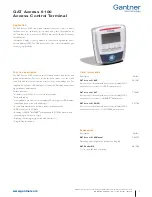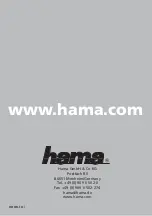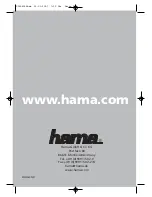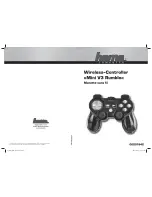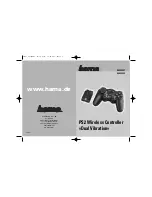
AW-SMU06EN
Page 2 of 4
2 Specifications
– continued
2.3 Pressure characteristics
(Representative values)
Conditions: Inlet pressure 0.7 MPa, Outlet pressure 0.2 MPa, Flow rate
20 /min (ANR)
2 Specifications
– continued
2.4 Port size and weight
Model
Port size
Weight (kg)
AW20-B
1/8,1/4
0.20
AW30-B
1/4, 3/8
0.36
AW40-B
1/4, 3/8, 1/2
0.66
AW40-06-B
3/4
0.72
AW60-B
3/4, 1
2.05
Table 2
2.5 Design/Selection
Warning
Residual pressure disposal (outlet pressure removal) is not possible
for the AW20-B to AW60-B even though the inlet pressure is
exhausted. When the residual pressure disposal is performed, use
the filter regulator with backflow function (AW20K-B to AW60K-B).
The standard bowl for the air filter, filter regulator, and lubricator are
made of polycarbonate. Do not use in an environment where they are
exposed to or come in contact with organic solvents, chemicals,
cutting oil, synthetic oil, alkali, and thread lock solutions.
2 Specifications
– continued
Effects of atmosphere of organic solvents and chemicals, and where
these elements are likely to adhere to the equipment.
Chemical data for substances causing degradation (Reference)
Type
Chemical name
Application examples
Material
Polycarbonate Nylon
Acid
Hydrochloric acid
Sulfuric acid,
Phosphoric acid
Chromic acid
Acid washing liquid
for metals
Alkaline
Sodium hydroxide
(Caustic soda)
Potash
Calcium hydroxide
(Slack lime)
Ammonia water
Carbonate of soda
Degreasing of metals
Industrial salts
Water-soluble cutting
oil
Inorganic
salts
Sodium sulfide
Sulfate of potash
Sulfate of soda
–
Chlorine
solvents
Carbon tetrachloride
Chloroform
Ethylene chloride
Methylene chloride
Cleansing liquid for
metals
Printing ink
Dilution
Aromatic
series
Benzene
Toluene
Paint thinner
Coatings
Dry cleaning
Ketone
Acetone
Methyl ethyl ketone
Cyclohexane
Photographic film
Dry cleaning
Textile industries
Alcohol
Ethyl alcohol
IPA
Methyl alcohol
Antifreeze
Adhesives
Oil
Gasoline
Kerosene
–
Ester
Phthalic acid dimethyl
Phthalic acid diethyl
Acetic acid
Synthetic oil
Anti-rust additives
Ether
Methyl ether
Ethyl ether
Brake oil additives
Amino
Methyl amino
Cutting oil
Brake oil additives
Rubber accelerator
Others
Thread-lock fluid
Seawater
Leak tester
–
: Essentially safe
:Some effects may occur
: Effects will occur
Table 3
When the above factors are present, or there is some doubt, use a
metal bowl for safety.
2.6 ON indicator
If the AW-B is equipped with a gauge, the gauge will indicate the
presence of pressurised air.
Caution
Special products might have specifications different from those shown
in this section. Contact SMC for specific drawings. These drawings will
give the appropriate specification details and compliance with the safety
principles of ISO 13849, if applicable.
3 Installation
3.1 Installation
Warning
Do not install the product unless the safety instructions have been read
and understood.
3.2 Environment
Warning
Do not use in an environment where corrosive gases, chemicals, salt
water or steam are present.
Do not use in an explosive atmosphere.
Do not expose to direct sunlight. Use a suitable protective cover.
Do not install in a location subject to vibration or impact. Check the
product specifications.
Do not mount in a location exposed to radiant heat.
3 Installation
– continued
3.3 Piping
Caution
Before piping make sure to clean up chips, cutting oil, dust etc.
When installing piping or fittings, ensure sealant material does not enter
inside the port. When using seal tape, leave 1.5 to 2 threads exposed
on the end of the pipe/fitting.
Tighten fittings to the specified tightening torque.
3.4 Lubrication
Caution
SMC products have been lubricated for life at manufacture, and do not
require lubrication in service.
If a lubricant is used in the system, use turbine oil Class 1 (no additive),
ISO VG32. Once lubricant is used in the system, lubrication must be
continued because the original lubricant applied during manufacturing
will be washed away.
3.5 Mounting/Adjustment
Warning
Set the regulator while verifying the displayed values of the inlet and
outlet pressure gauges. Turning the regulator knob excessively can
cause damage to the internal parts.
Do not use tools on the pressure regulator knob as this may cause
damage. It must be operated manually.
Caution
Be sure to unlock the knob before adjusting the pressure and lock it
after setting the pressure. Failure to follow this procedure can cause
damage to the knob and the outlet pressure may fluctuate.
• Pull the pressure regulator knob to unlock. (You can visually
verify this with the “orange mark” that appears in the gap.)
• Push the pressure regulator knob to lock. When the knob is not
easily locked, turn it left and right a little and then push it (when
the knob is locked, the “orange mark”, i.e., the gap will
disappear).
A knob cover is available to prevent careless operation of the knob.
Refer to the catalogue for details.
When the bowl is installed on the AW30-B to AW60-B, install them so
that the lock button lines up to the groove of the front (or the back) of
the body to avoid drop or damage of the bowl.
Orange
mark
Lock
button








